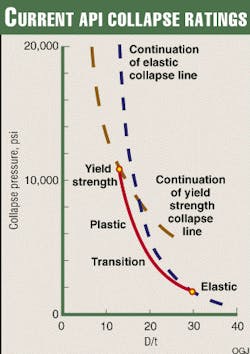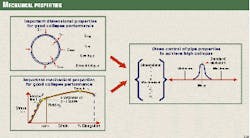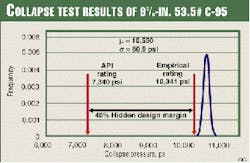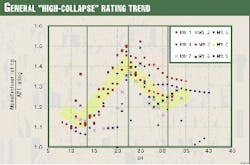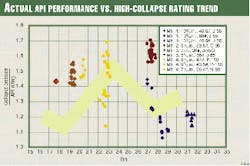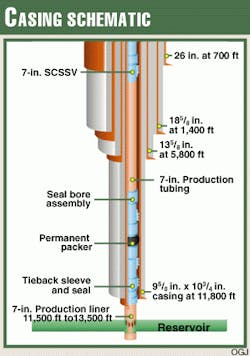Pipe-collapse issues provide economic opportunities
To overcome design issues that affect well economics and operations, historical methods of casing design require revisions.
Engineers base most of their casing design approaches on a set of assumed extreme field loads and minimum pipe performance properties. This approach, however, has resulted in a significant amount of over design.
Ironically, most failures and problems occur near the pipe connection, which requires greater attention in terms of load-integrity analysis, selection, manufacturing quality control, or field running assurance.
There are also a number of potential failure modes, such as buckling, connection back-outs, and wear issues that are improperly addressed by conventional design methodology.
With this brief background, significant opportunities exist to improve current casing and well-design procedures.
Drivers behind casing design
To prioritize opportunities for tubular and well design cost savings, it is important to understand what considerations drive tubular specifications. To work through this process, design bases need to be established for each well of interest.
In its simplest form, a design basis should cover assumed load cases for each tubular item along with assumed performance properties and minimum desired design factors.
When such bases of design are established for current wells, the majority of both drilling and production tubulars will be governed by collapse design considerations. Substantial discussion is therefore warranted on the assumed collapse load cases used in many well designs.
This exercise will enable each operator to identify factors that currently govern tubular designs while enhancing the potential for cost savings through focused optimization.
As an independent confirmation that collapse specifications govern the selection of most oil field tubulars, the industry should consider the proliferation of high-collapse tubular grades. Manufacturers have created and pursued these grades because they target a known constraint.
Basic collapse modes
Tubular collapse can occur due to structural instability of the tubular, the initiation of material yielding, or a combination of both mechanisms. Collapse due to instability is known as "elastic collapse" and occurs before stresses reach material yield. On the other hand, yield collapse occurs when stresses in the tubular reach the material yield strength.
Elastic tubular collapse can be solved by application of the classical theory of elastic stability.1-3 Because yield collapse requires a suitable theory of plasticity, there is significant variation in the models used to calculate yield collapse.
The various yield-collapse formulations differ in how collapse is defined, the plasticity model used to predict collapse, and the assumptions about the geometry of the tubular.
API collapse ratings
There are four collapse-rating equations within current API specifications: elastic collapse, transition collapse, plastic collapse, and yield collapse equations.4 Elastic collapse is used to rate high D/t ratio pipe (D = pipe OD; t = pipe WT) and is based on a theoretical derivation for elastic stability.
Yield strength collapse is used to rate low D/t ratio pipe and is based on a theoretical derivation for initiation of yield at the pipe ID. The plastic collapse equation is used for D/t values between the elastic and yield modes.
The plastic collapse equation was statistically derived from 2,448 collapse tests conducted in the early 1960s. Following derivation of the plastic collapse equation, it was observed that the plastic collapse regression and the elastic collapse equation did not intersect (Fig. 1).
As a result, API generated the transition collapse equation specifically to bridge the plastic collapse and elastic collapse equations. The transition collapse equation thus provides an artificial bridge for a smooth transition between otherwise disjointed rating equations. The API collapse ratings also consider the effect of axial loads.5 6
A key point regarding the API collapse ratings is that they were derived from test data generated on tubulars manufactured in the early 1960s and late 1950s. Several studies of collapse data have shown that the API collapse ratings can be very conservative.
Although the evaluation of equations should be conservative, they should not be excessively conservative since this represents economic waste. This article presents evidence that the current API rating equations are in many cases conservative.
High-collapse ratings
The variables that influence tubular collapse performance are well known. These factors include the following dimensional and mechanical strength properties: average OD, OD variation (ovality), average wall thickness, wall variation (eccentricity), 3D geometric profile,7 elastic modulus, elastic limit, yield strength, sharpness of stress-strain curve near yield (Fig. 2), and residual stresses.
Improving the mechanical and dimensional properties of the pipe above those normally provided will obviously improve the pipe's collapse resistance. However, quantifying the improved properties and understanding this impact on collapse performance is challenging.
In order to ensure superior casing performance, the buyer must be able to specify and verify the properties responsible for the improved performance. As Fig. 2 shows, high-collapse ratings should be attained through specific and consistent levels of mechanical properties and dimensions.
The solution is a product specification that combines both absolute minimum and maximum limits with statistical requirements for key properties. One basis for the statistical specification should be the actual property statistics of the test specimens used by the manufacturer to generate the high-collapse product database.
Therefore, buying high-collapse pipe against standard specification requirements such as API 5CT, or against no written specification while using an elevated guaranteed (high collapse) rating, places extensive credit on the manufacturer. Under such a blind approach, and without an understanding of the properties required to achieve enhanced performance, there exist no means to ensure that the specified performance is put into place.
Other considerations include ongoing manufacturing capabilities. A frequent mistake may be to place confidence in an experimental rating derived by testing "Cadillac" specimens and then allow a looser specification for the production run. Obviously, this leaves the door open for products that may not provide the performance of the test specimens.
Insights
In order to clarify API and high-collapse tubulars, a study of collapse ratings was conducted based on product information, technical background, API catalog ratings, published collapse ratings and their rationale, test data, reports, and proprietary oil country tubular goods (OCTG) data obtained from major tubular manufacturers. An examination of the data supports several conclusions:
- Most high collapse products are clustered in the transition and plastic collapse ranges (15< D/t<25). This is also the D/t range for the most commonly used OCTG items.
- There are no standards for high collapse pipe. Different manufacturers rate their products differently, making it difficult to perform valid comparisons.
- Cases were found in which the high-collapse ratings failed to maintain the same safety margin provided by the API ratings. Cases were even found in which high-collapse products failed to provide the same effective rating as API products.
- In several cases, the validity of the high-collapse ratings was fully verified. And on an even more positive and important note, many cases were found in which API products provided much if not all of the benefits of the high-collapse products.
Improved performance vs. API tubulars can be obtained in legitimate high-collapse grades. The increase in performance relative to a quality API product, however, is probably overstated because of the conservative nature of the API ratings. Some specific examples illustrate this point.
Economic opportunities
Fig. 3 shows collapse testing results on 9 5/8-in., 47 lb/ft, P-110 tubulars that have an API rating of 5,300 psi. Eight tests were conducted from several heats from a single, high-quality manufacturer. As shown, the mean of these tests was 7,919 psi and the standard deviation was 210 psi.
Using the same rating methodology as the API regression (mean less 2.574 standard deviations), an empirical product rating is calculated at 7,379 psi. Thus, the empirical rating is about 40% higher than the API rating.
This 40% margin represents an economic opportunity to reduce tubular cost that could also affect other aspects of well design. As a second example, Fig. 4 shows results for 95/8-in., 53.5 lb/ft, C-95 casing also from a single, high-quality manufacturer.
In this case, the empirical rating is 10,341 psi, which is also about 40% above the API rating of 7,340 psi. These are two clear examples that high quality-API products can provide actual performance well in excess of the API performance properties. The industry, however, must not assume that this is always the case.
Fig. 5 shows the general trends of high-collapse products in the marketplace. This figure shows these products in terms of the ratio of their rating versus the API rating as a function of the product D/t ratios. There is an identifiable trend in the various high-collapse tubular ratings as indicated by the broad band in the figure.
Also of note, however, is the substantial scatter of ratings from different manufacturers and different products. While the scatter points to a lack of standards for and understanding of proprietary high-collapse products, the existence of the general trend line speaks to a probable systematic issue with current API ratings.
Note that the largest performance margins are in the plastic and transition rating areas. Also, the magnitude of these margins, 30, 40, even 50%, indicates the potential tubular cost savings as collapse considerations govern most tubular designs.
Fig. 6 shows the general high-collapse rating trend on a plot with various sets of actual data from API tubulars. As shown in a number of instances, high-quality API tubulars provide similar performance to those claimed for high-collapse tubulars. The message here is that the manufacturing techniques and control measures applicable for a high-collapse product can also be present during the manufacturing of API tubulars.
Also of very important note is that some of the API tubular test data do not meet the high-collapse trends other than from a statistical standpoint (Fig. 6). Thus, no assumptions should be made regarding performance margins that any API tubular may have relative to the rating.
Because most tubular specifications and inspection procedures are based on absolute limits and "go or no-go" approaches, there is currently a lack of quantitative data on which to characterize pipe quality. The quantification of pipe quality measures, such as the key parameters listed above, is an ongoing and important step that will allow the differentiation of manufacturer quality and more general interpolation and extrapolation of these performance measures.
Fortunately, there are exciting advances ongoing in pipe-inspection technology such as high-speed ultrasonics and optical-based dimensional inspections that enable quantitative characterization of pipe quality.
For example, high-speed ultrasonics provides an ability to characterize pipe wall thickness in a detailed fashion, including full-length, 100% coverage. Additionally, new optical systems and other techniques are providing full-length OD and ovality characterization.
Business impact
The economic impact of advanced casing design and rating technology can be substantial, as shown in the Yacheng gas project in the South China Sea. Fig. 7 shows the basic well configuration in which tubular collapse issues govern the design aspects of surface casing, protective casing, production casing, production liner, and production tubing.
In several cases, focused qualification efforts were initiated to validate specific high-collapse products and their ratings. As with most high-collapse products, part of the design basis for these products was to ensure elevated yield strength with tight distributions across the allowable 30,000-psi yield range between minimum and maximum yield.
This technique, however, became very challenging upon examination of the 7-in. 13Cr (13-Chrome resistant steel alloy) tubulars. Because of the tighter 15,000-psi yield range allowed for L80-13 Cr and other controlled yield products, manufacturers were unsure whether a high-collapse product could be made.
In fact, when ARCO first requested quotes on high-collapse 13 Cr products, several manufacturers declined to quote the order while others quoted very high costs. Because there were no commercially available high-collapse 13 Cr tubulars, the approach caused some initial confusion. ARCO withdrew all bid requests at this time and reissued them as standard L80-13Cr products with a collapse testing program.
The testing program demonstrated that the product had an effective performance level 20% above the API rating.8 As a result, all of the tubulars, including the 13 Cr, were optimized for the project thereby saving approximately $2 million.
Other areas
More recently, ARCO structured a project to demonstrate the applicability of the advanced design techniques to a variety of well types around the company. This was important in order to demonstrate the full potential of the technology and to eliminate any bias that the technology may have to only critical well applications.
As shown in Table 1, a number of projects were affected. These included development projects on the Alaskan North Slope, coalbed methane projects in New Mexico, international exploration wells, South American development projects, Gulf Coast development wells, and so on. Altogether, advanced tubular design affected seven projects for a total cost savings of $4.5 million.
Additionally, design changes enabled by this technology may also affect overall well construction. An example is the "up-rating" of a protective casing string to eliminate a production tieback.
This type of successful design change addressed both burst-and-collapse design considerations. In such cases, cost savings from the technology involve not only tubular product cost savings but rig time.
Another important application of the technology is the ability accurately to assess well integrity in ongoing operations. An example includes drilling operations that encounter casing string wear where an accurate assessment of remaining integrity can make decision-making differences concerning whether to suspend drilling, continue drilling, or run a tieback.
Burst, collapse, tension, and connection considerations are usually analyzed in these situations. As noted, the impact of the technology can substantially affect field operations and business strategies.
Although the above cost savings are remarkable, the potential for other areas of application is even greater. The above strings were accumulated on a demonstrative basis to show that the technology can be applied to a wide variety of projects.
For example, many other projects were conducted without application of the technology and cost savings were missed. Fig. 8 shows the full potential of the technology if organizational measures are taken in a global context. In such broad application, savings accumulate string by string, well by well, and field by field.
A joint-industry project
Although the advanced casing design technology described here is currently proprietary, work is under way to enable use of the technology on a broader basis by the industry. In particular, both the API and its international counter-part, the International Standards Organization (ISO), are actively looking at updating tubular performance property standards.
This effort will include updates of the API 5C3 and ISO 10400 standards. Unfortunately, the API and ISO standardization organizations rely on voluntary work to develop and advance the standards. In recognition of this constraint, efforts are also underway to organize a joint-industry project (JIP) to assist API and ISO in this endeavor.
The JIP has been organized under the auspices of the Drilling Engineering Association (DEA) and is known as DEA-130. DEA-130 will involve physical-collapse testing of a large number of tubular products obtained from a variety of manufacturers.
A number of operators, regulatory organizations, and API have agreed to sponsor DEA-130. Since the JIP is still being organized at this time, it is premature to list the sponsoring companies. In the near future, DEA-130 will likely be fully subscribed and activated so that the industry as a whole can begin to move forward on these fundamental tubular technologies.
References
- Timoshenko, S., Theory of Elastic Stability, 2nd Edition, McGraw-Hill, New York, 1963.
- Clinedinst, W.O., 1940, "A Rational Expression for the Critical Collapsing Pressure of Pipe Under External Pressure," Drilling and Production Practices, API, Dallas, pp. 383-91.
- Holmquist, J.L. and Nadai, A., "A Theoretical and Experimental Approach to the Problem of Collapse of Deep-Well Casing," Drilling and Production Practices, API, Dallas, 1940, pp. 392-420.
- API Bulletin 5C3, Bulletin on Formulas and Calculations for Casing, Tubing, Drill Pipe, and Line Pipe Properties, 6th Edition, Oct. 1, 1994.
- Pattillo, P.D., and Huang, N.C., 1982, "The Effect of Axial Load on Casing Collapse," Journal of Petroleum Technology, January 1982, pp. 159-64.
- Clinedinst, W.O., "Calculating Collapse Resistance under Axial Stress Using Existing API Collapse formulas and the Strain Energy of Distortion Theory of Yielding," presented to the API Task Group on Performance Properties, Bal Harbour, Fla., 1981.
- Assanelli, R.G, Toscano, R.G., Johnson, D.H., and Dvorkin, E.N., "Collapse Behavior of Casings: Measurement Techniques, Numerical Analyses and Full Scale Testing," SPE Paper ATW presented at the SPE Applied Technology Workshop on Risk based Design of Well Casing and Tubing, May 7-8, 1998, The Woodlands, Tex.
- Payne, M.L., Zerbi, J.L., and Sims, D.C., "Tubular Design Optimization for ARCO China's Yacheng 13-1 Development," SPE paper 29926 presented at the International Meeting on Petroleum Engineering, Beijing, Nov. 14-17, 1995.
The Authors
M.L. (Mike) Payne is an advisor with ARCO Technology & Operations Services. He has 18 years' industry experience with expertise in drilling mechanics, drilling dynamics, tubular engineering, and well design.
Payne holds a PhD in mechanical engineering from Rice University in Houston. He has been awarded the 2000 Drilling Engineering award by the Society of Petroleum Engineers.
U.B Sathuvalli is a research engineer in the technology operations and drilling group at ARCO Technology & Services. Since 1996, he has worked on aspects of drilling and completion that involve thermal-fluid sciences and mechanics, such as force transfer in coiled tubing and the effects of heat transfer in offshore wells.
Sathuvalli holds a PhD in mechanical engineering from Rice University, a master's degree in electrical engineering from the Indian Institute of Science, and a bachelor's degree in electrical power engineering from Mangalore University.

